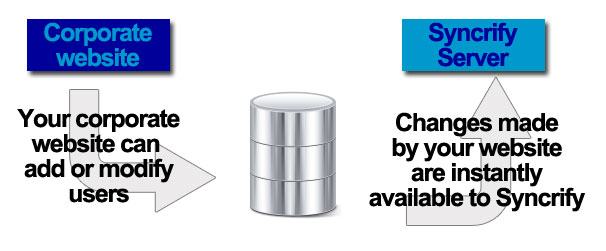Synametrics Technologies
Revolving around the core of technology
Using an RDBMS in Syncrify
By default, Syncrify does not require any database. It stores everything in local files, most of them are in XML format. Often companies, particularly service providers, have thousands of users and they want to maintain the users in Syncrify programmatically.Consider the following scenario where this feature makes most sense.

Most ISPs have their own website where they offer other services besides remote backup. By storing the user information in a database, information can be modified in real-time without using Syncrify's web interface.
Here are some pros and cons of using a relational database.
Advantages
- External management - you can add/view/modify users from another program, such as your website.
- Highly scalable
Disadvantages
- Additional dependency - if your database goes down, Syncrify goes down.
- Additional configuration
Prerequisites
At this time, Syncrify supports two database Vendor:- MySQL
- MS SQL Server (with TCP/IP for the protocol and SQL Server Authentication model for security enabled.)
- CREATE TABLE
- SELECT
- UPDATE
- DELETE
Configuration
Follow the steps below to configure database.- Log in as admin using the web interface.
- Click on the Configuration link on the left hand side
- Click on More Configuration Options on the top right, then click on Configure RDBMS.
- Select the type of database vendor.
- Syncrify will download necessary files for establishing connection from Synametrics' main website
- Once the files are downloaded, it will prompt you for connection parameters such as host name, TCP/IP port, user name and password.
- A new table called synusers will be created if it does not exist
- You can also import existing user accounts to the newly created table if desired.
